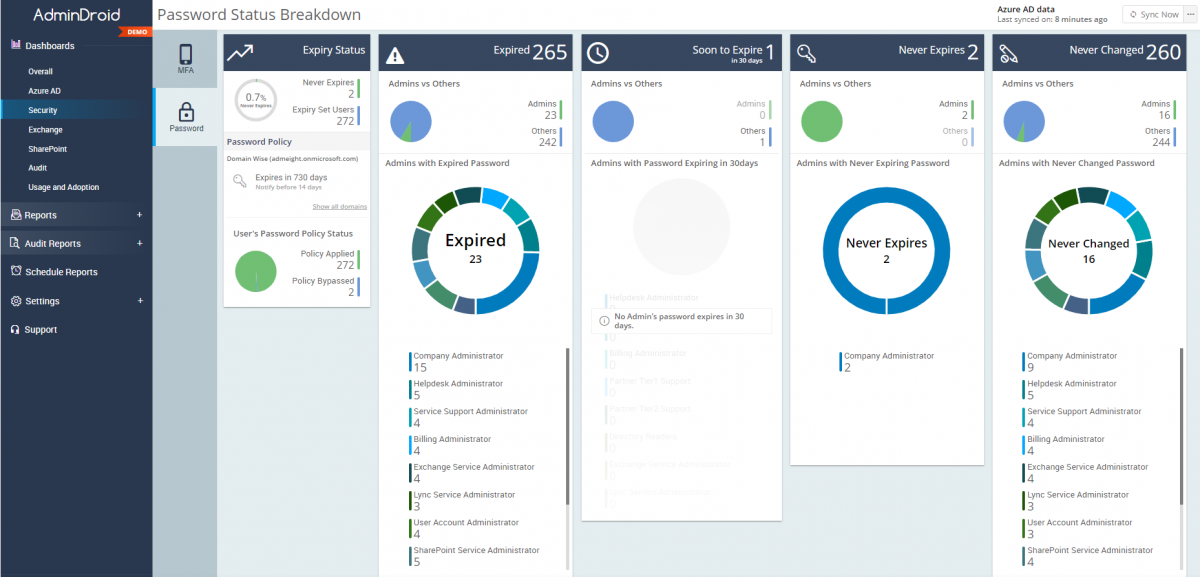Disclaimer: This review was done based on license provided from vendor to MVPs. Purpose of this review is to provide an overview of the software functionality, with no intention to provide free marketing or sales initiatives. Author was not compensated for this review in any way.
Each organization that uses Office 365 needs reporting from time to time. For bigger organizations, this need is even more frequent. And while you can get some basic GUI based reporting in Office 365 admin center, for more detailed reporting you would probably need to dig in to PowerShell. If you are not an expert (or fan) of the PowerShell or you simply like GUI based reporting with a lot of details, you might want to look at some third-party solutions. One of them, which does a very nice job in this field is AdminDroid.
AdminDroid is a GUI based console, that runs as a web service on your local host and connects to your Office365 tenant to pull various kinds of reports for you. In general, you can pull all these reports by yourself, by using PowerShell, but you will need a lot of knowledge and a lot of time to do it. Also, you might need A LOT more time to pack all these reports in graphic format and that’s the real magic that AdminDroid does. It “listens” to your tenant activities and provide you with almost real time info about various things. For this purpose, you will be to provide a service account on your tenant with Global reader permissions.
When you configure AdminDroid for your Office365 tenant, you will need to leave for some time to gather data. Some data will be available very fast, but for some data you will need to wait for a few hours.
AdminDroid console is divided in two parts – Dashboards and Reports/Audit Reports. While on Dashboard you can see some most important data about your tenant and objects in your tenant, in Reports section you can generate various reports using several filters and download them in appropriate format.
For example, home (Overall) dashboard shows you current state of objects in your AzureAD, Security features such as MFA, state of mailboxes on Exchange Online, as well as data about SharePoint online. See example below:

If you need to see more detailed data, each of the key Office 365 services has its own Dashboard. If you click on Azure AD you can see details about your license usage, users and groups and their activities and many other details. On Exchange dashboard you can see details about mailboxes in your organization, but also charts on most active or inactive users, mailbox usage, mailbox traffic and mailbox delegation.

Dashboard called Usage and Adoption is especially interesting. Here you can see details about activities per job title, city, state, country and company. So, if your users are in multiple cities/states and you want to see frequency of their activities – this is the place to look for. If you want to see how your Project Managers perform and how they use Office 365 services you should also look here.
However, while looking at the Dashboards might be very interesting, even funny, the real power of AdminDroid is in its reporting capabilities. For each of the key Office365 services you can run dozens of various reports. For each report you can set a view and configure filters to narrow your results. Reports can be downloaded in HTML, PDF, CSV, XLS, XLSX and RAW formats. Reports can be very detailed, as well as large, so it is highly recommended to use filters before running a report. Especially if you have a lot of users.
Audit reports are even more interesting. For example, you can pull a report about all performed SendAs activities in your organization. You can also get a report on each mailbox activity performed on a single mailbox or multiple mailboxes. For AzureAD, you can track login activities, password change/reset activities, admin role management, audit policy management and many more. AdminDroid can even connect to your Intune and pull reports from there. However, if you explore SecureScore reports you can find a lot more than Intune reports – in general, complete Secure Score of your company is available there.
Tracking file and folder-based activities on SharePoint and OneDrive can be very useful for troubleshooting purposes. You can audit and pull in report, every single file/folder activity performed on your tenant, with a bunch of additional details.

Security based reports also provides data that might be very useful. I’ve found few reports very useful there. For example, you can quickly get a list of users that failed to pass MFA challenge. Or users that are trying to sign in with expired passwords. There is also a special report on Admin Login failures as well as report on history of admin role assignments activities.
All reports can be pulled on demand or scheduled to perform. You can choose between 796 preconfigured reports to schedule, which is really an impressive number.
So, if you are looking for a good, GUI based, reporting solution for your Microsoft 365 / Office 365 tenant, AdminDroid is definitely worth to try. Pricing is pretty decent, and you can even get a free version – if you are satisfied with Azure AD Reports and Dashboards only. MVPs (Office Apps & Services) can get a free license, while edu and non-profits are having quite a big discounts. Take a look here.

